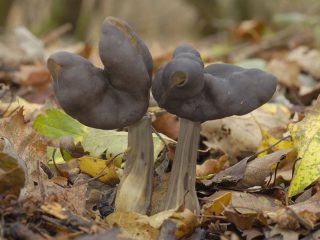Content
Kele's lobe is a rare species of mushroom. In Latin it is called Helvella queletii, the synonymous name is Helvella Kele. Belongs to the Lopastnikov genus, the Helwellian family. Named after Lucien Quelet (1832 – 1899). This is a French scientist who founded the mycological community in France. It was he who discovered this type of mushroom.
What do Kele Helvelians look like?
Young mushrooms have cup-shaped caps that are flattened on the sides. Their edges are slightly curved inward. Mature lobes become saucer-shaped, with smooth and entire or jagged edges.
The skin on the upper surface is colored in pale grayish-brown, brownish, yellow-gray shades. When dry, the cap becomes light gray, and a whitish or gray granular coating appears on it, which consists of tufts of short hairs.The inner surface is smooth, darker, and can range from gray-brown to almost black.
The leg is slender, smooth, not hollow, grows 6-10 cm in length. Some sources provide information that its thickness can reach 4 cm, but more often it is thinner, about 1-2 cm. Its shape is cylindrical or club-shaped, and may expand slightly towards the base.
The leg is ribbed. The number of ribs is from 4 to 10, the direction is longitudinal. They do not break off at the transition point between the cap and the stem. Its color is light, whitish, in the lower part it is darker, in the upper part it is reddish, grayish, brownish, often matching the color of the outer part of the cap.
The pulp of the mushroom is light in color, brittle and very thin. Gives off an unpleasant odor. Has no taste value.
Helvella Kele belongs to the category of marsupial mushrooms. It reproduces by spores located in the fruiting body, in the “bag”. They are smooth, elliptical in shape, with one drop of oil in the center.
Where do Kele blades grow?
Helwella is found in forests of different types: deciduous, coniferous, mixed. She prefers well-lit areas. It grows on soil, less often on rotten wood or dead wood, usually singly or in small groups.
The species is distributed on several continents. Mushrooms can be found throughout Eurasia and North America. In some countries: the Czech Republic, Poland, the Netherlands, Denmark, Helwella Kele is listed in the Red Book. It is not protected on Russian territory. Its distribution area is extensive. The species is found in many regions of the country, especially often in the Leningrad, Moscow, Belgorod, Lipetsk regions, Udmurtia and Stavropol.
Helvella Kele appears early.The ripening period begins in May. Fruiting lasts until July inclusive, and in the northern regions it lasts until the end of summer.
Is it possible to eat Kele Helwella?
There is no scientific evidence that Helwella Kele can be eaten. The species is not even classified as conditionally edible; there is no description of its nutritional value or belonging to one or another taste category.
At the same time, information about the toxicity of mushrooms is also not provided. There have been no cases of Helvellus poisoning in Russia. However, the small size and unpleasant odor of the pulp make the lobe unsuitable for consumption.
Conclusion
Helvella Kele are spring mushrooms that appear in forest areas as early as May. Sometimes the species grows in urban areas. But to find it, it will take a lot of effort - the Kele lobed is rare. Collecting it is pointless and even dangerous. In European countries, cases of poisoning by blades have been recorded.











